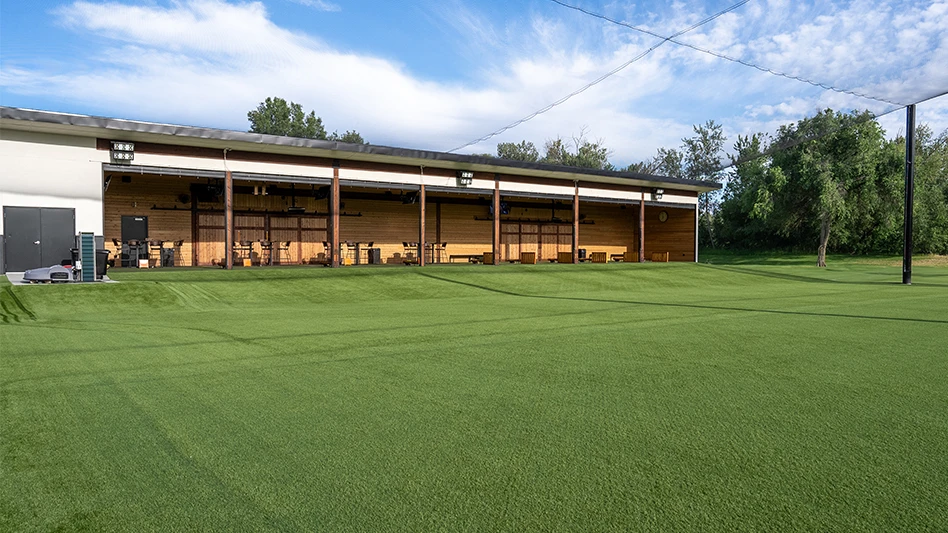
Michael Bonocore (2)
Architect Brian Curley received an opportunity to put his beliefs about driving ranges into execution at a new, state-of-the-art practice facility called The Barn at The River Club in Boise, Idaho.
The River Club course opened in 1916 as Boise Country Club, designed by Chandler Egan. It was renamed Plantation Country Club in 1930 and became The River Club in 2021.
In 2018, the private course was acquired by California developer Will Gustafson, who hired Curley to reimagine it. Part of the project required reducing the amount of land occupied by the golf course to allow for 20 acres of future development along a busy east-west transportation corridor.
“For many golf courses, driving ranges are not a good use of space or resources,” Curley said. “On a lot of sites, the wisdom of using 12 acres or more of land and a lot of water just to allow people to whack balls is debatable.”
Curley’s new design involves shortening the course from 6,376 yards, par 71, to around 5,800 yards, par 68. He said the changes will essentially equate to the removal of back tees and result in no loss of effective distance for the vast majority of golfers.
Another significant element of the design is the addition of a well-appointed netted area for warm up, designed to replace the driving range that was lost to development in the 1970s. The Barn is a unique practice facility with 10 bays designed for year-round use. Four of the bays are equipped with Trackman to provide golfers with instant feedback on their swing. In Boise, where summer temperatures often approach 100 degrees, The Barn allows golfers to remain cool and comfortable, as they practice their swing under the misters and fans, while enjoying full bar and food service ordered via their smartphone.
A robotic golf ball retrieving vacuum (as yet unnamed!) keeps things tidy by retrieving the hundreds of golf balls, returning them to a large bin to distribute again to golfers. In chilly winter months, The Barn transitions to a full-service simulator building, with golfers swinging into screens with high-definition projections of hundreds of different golf courses, while heaters provide protection from the elements.


“In many markets with seasonal golf climates, it is far more important to have a good golf course than it is to sacrifice course quality to accommodate a practice range,” Curley said. “In these circumstances, driving ranges are becoming things of the past. Golfers, especially younger players, are perfectly content to hit balls into a warm-up net with instant statistical feedback. Watch tour professionals like Bryson DeChambeau practice nowadays: they don’t actually watch the ball flight. They make the swing and turn straight to their Trackman to get the information they need.
“If a practice facility/simulator center is well done, it can be a major positive amenity that allows members to be active year-round. The combination of a high-tech, fair-weather warmup facility that serves as a simulator building when weather is foul is a winning combination that provides members with the best possible golf experience year-round.”
Curley’s new practice facility at the River Club, which officially opened last month for the golf season, occupies only half an acre of land, and features artificial turf. “It is about a hundred feet deep to the net, a distance that makes it easy to get a feel for ball flight,” Curley said. “While hitting, you look straight down a long corridor of existing golf, so it feels like hitting into a fairway.”
The Barn enabled Curley to satisfy the owner’s demanding design standards while optimizing the golfer’s experience.
“The place rocks!” Curley said. “This is the future. People are crazy about it.”
Latest from Golf Course Industry
- From the publisher’s pen: Conscientious of a bigger role
- Bernhard and Company partners with Laguna Golf Phuket
- Terre Blanche showcases environmental stewardship
- VIDEO: Introducing our December issue
- Bernhard and Company introduces Soil Scout
- Nu-Pipe donates to GCSAA Foundation’s Centennial Campaign
- GCSAA enhances golf course BMP tool
- Melrose leadership programs sending 18 to 2026 GCSAA Conference and Trade Show





